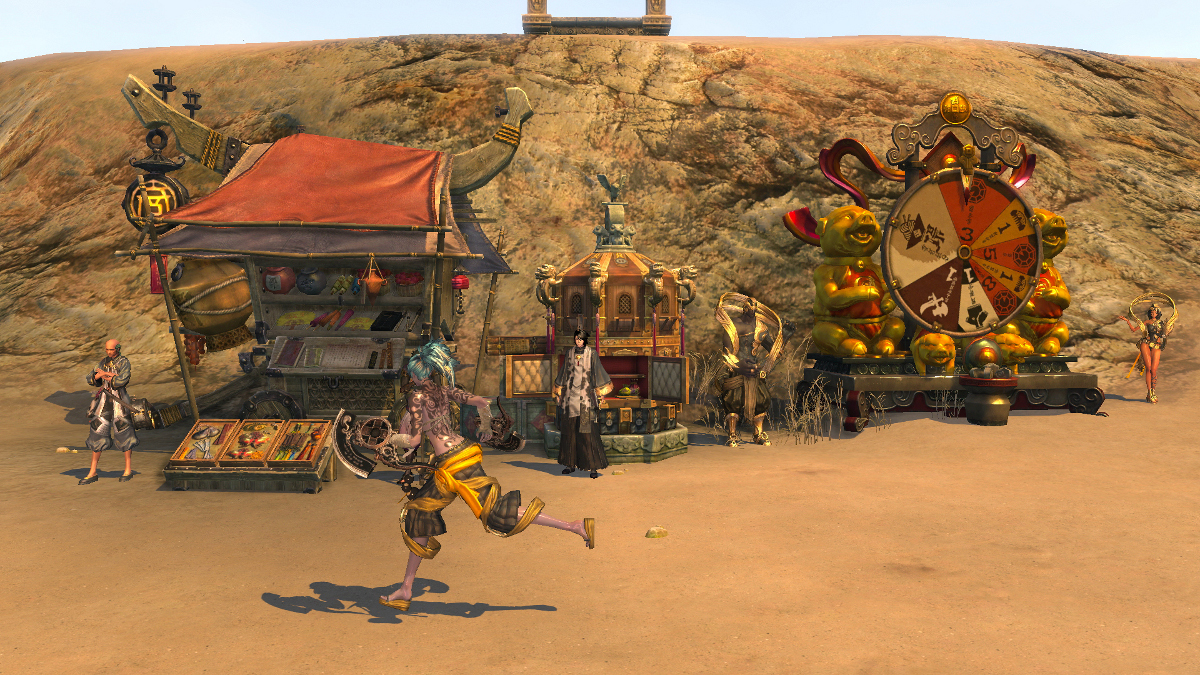NCSOFT will be bringing its wildly successful Blade & Soul to multiple regions in the coming months, and we were recently afforded a golden opportunity to spend some hands-on time with the game. While the project is currently considered to be in pre-alpha state, don’t let the software development jargon fool you. The game is already in great shape from what we were able to experience, and I walked away with high hopes that the closed beta – set to kick off sometime this fall – will be one of the more noteworthy for the modern era of MMOs.
While most MMO betas are a process of debugging code chugging away in the background, and the illusion of player feedback having any possible impact on core game features, things will work a bit different in Blade & Soul. In particular, the team will be attempting to determine how best to tweak existing systems much like Taiwan online casinos at Kajino.com does, and features to best fit a regional audience that tends to have some very specific expectations and preferences when it comes to the core MMO experience.
The beta will ultimately help determine things like the optimal leveling curve, rather than the usual scramble to get basic chat or social tools in place. The latter simply won’t be an issue with Blade & Soul considering we’ll be getting a game client that already comes bundled with the kind of post-launch features and polish we usually don’t see for the first year or more.

Blade & Soul – The Story So Far
We first learned about NCSOFT’s intent to bring Blade & Soul to North America nearly three years ago, and following some initial news and updates surrounding the project, the team largely went dark. While this could be partially attributed to providing ample clearance for Carbine Studios’ launch for WildStar, quite a bit goes on under the hood and behind the scenes to bring a game of this size and scope to new regions.
Among other things, three million words needed to be translated. To put that number into perspective, the average article length on Ten Ton Hammer is roughly 1,000 words. It would take 3,000 of those articles to reach the 3 million word mark – easily an entire year’s worth of content for most websites that average somewhere around 8-10 articles per day.
Raw translations also don’t typically work out so well, as plenty of meaning and intrigue can oftentimes get lost in translation. As such, many of the skill names or other more official sounding terms we experienced in-game during our hands-on session were considered works in progress, so I’ll throw out a minor caution that I’ll be discussing certain aspects of the game in broader terms rather than drilling down into specific skill descriptions or nomenclature.
The other major thing that has occurred in the time since Blade & Soul was first announced as a pending project for North America are the wildly successful launches in South Korea, China, Taiwan, and Japan. I’m not sure what the Korean word is for hotcakes, but I’m fairly certain it would have been used to describe the sales figures for Blade & Soul in the time since the game’s launch.
This delay between regional deployments will ultimately benefit players in North America. By the time it enters closed beta this fall, the client will already have a number of post-launch enhancements bundled into the core experience, along with the kinds of performance optimizations we typically won’t see until long after a new product’s launch. I consider this huge for a number of reasons, not the least of which is the “holy crap, that’s awesome” cinematic moments that happen as part of the normal flow of gameplay.
While the game does offer plenty of killer packaged cinematics, the overall presentation is truly unlike anything else you’ve witnessed before in an MMO. Characters traverse some of the most vertical play spaces in the genre with blazing speed, through a combination of active skill usage and environmental trigger points. Diving off of cliffs is likely to become your new favorite pastime once you’ve felt the rush of dashing through the sky like a superhero minus the kitschy cape, tights, and spandex underwear worn on the outside of your pants.

The Broad Strokes
Prior to getting to dive into the game, I was treated to a general overview of the project by none other than the mighty Omeed Dariani who recently joined the NCSOFT camp as Community Director. The same infectious enthusiasm that Omeed brought to the table previously for Landmark and EverQuest Next was immediately evident, and bodes well for how Blade & Soul will resonate on the community front.
Following a broad strokes overview of the setting and driving force behind your character’s journey in Blade & Soul, Omeed also walked through some of the game’s more noteworthy systems. In particular, I found the handling of costumes and how they are directly linked to the consensual open world PvP system quite compelling.
Plenty of MMOs have systems in place that let you toggle an invisible switch and flag your character for PvP. While I still think the original Priest of Discord system in EverQuest largely kicks every single MMO in the ass in this department, they have done some truly noteworthy things with the formula in Blade & Soul.
Along with the two main factions that players can choose to represent, there are also various groups that you’ll have the opportunity to earn reputation with. By equipping special cosmetic armors you will automatically be flagged for PvP and represent your chosen faction. There is a slight channeled cooldown to swap back out of PvP-mode, but it is currently a matter of seconds rather than the more common 2-5 minutes found in other MMOs.
Some of my best and most memorable PvP experiences in MMOs have been based on organic skirmishes directed by player choice rather than canned battlegrounds or arenas, so I’m very much looking forward to seeing how this aspect of Blade & Soul ultimately plays out.

Butt Steak aka Combat Impressions
While certain skills will trigger on-screen prompts for follow up attacks that form simple combo chains, the combat system in Blade & Soul begins to truly shine once you begin formulating your own attack chains from your available skills. One example of this involved using a skill that lets you effectively force choke your target Vader-style. While that's being channeled, I could quickly activate a second skill that set the ground beneath them on fire. While I'm sure there's a more technical descriptor for this simple combo, I couldn't shake the urge to mentally refer to it as the butt steak attack.
To extend this combo further, a well-timed third attack would allow me to kick my target away from my character, toss some fireballs in their face to sear their eyebrows to a nice golden brown, freeze them in their tracks while dodging backwards, and finish them off with a more powerful flame attack.
This back-and-forth play between using fire and ice attacks made me think of a much more fluid and interesting version of switching between elementalist attunements in Guild Wars 2, and with more purpose and intent to the action. The key mapping used in combat is also streamlined down to the point where you won’t need to deal with any of the more awkward reaches found in systems that wholly focus on the number keys.
Instead, skills are mapped quite smartly to the keys surrounding the traditional WASD movement keys. In the combo example used above, the key rotation was a very simple 4 > V > 2 > Double-tap S to dodge backwards > X. As new skills are learned or upgraded over time, this simplified mapping remains intact, and will no doubt allow players to retain focus on the action occurring on-screen rather than being diverted by a massive hotbar.
I was also able to get a feel for how certain combos could become more effective based on the type of enemy involved, or even general positioning. The same attack that allowed me to punt my enemy away from me could be used to boot them right off the edge of a cliff for some hefty falling damage when they landed somewhere below, for example.
While I'm sure players will eventually crunch numbers to determine the exact right skill chain to use for max DPS, I also got a very real sense that Blade & Soul has the potential to transcend the ultimate boredom of predictable rotations and best-in-slot BS that far too many MMOs devolve into once you've reached elder game content.
Another noteworthy aspect of combat that those of you familiar with Guild Wars 2 will appreciate is the fact that Blade & Soul has no dedicated healing classes. So not only is the hotbar very non-intrusive in the combat experience, players also won’t have to worry about spending hours staring at health bars in an attempt to keep group members alive.

Over the Top
Over the Top isn't just an awesomely terribad Sylvester Stallone film based on the exciting world of competitive arm wrestling. It's also one of the many ways you could describe certain elements of Blade & Soul's combat, class, and movement systems. Wind Walking really doesn't have a direct analog in a single other MMO, and is one of the best methods of capitalizing on a decidedly vertical playing space that trumps anything I've seen in a massively multiplayer game to date.
This simple concept of movement is also twice removed from what typically comes to mind when we consider the possibilities in western games. While we're still stuck in a cycle of trying to find ways of plugging Mirror's Edge into different genres to varying degrees of success, Blade & Soul takes movement to a whole new level.
While my hands-on time with Blade & Soul was ultimately somewhat brief, it did afford me the opportunity to walk away with a genuine sense of wanting more. At the end of the day an MMO needs to be fun, and based on my experiences with Blade & Soul so far, fun is definitely the name of the game.
To read the latest guides, news, and features you can visit our Blade & Soul Game Page.





